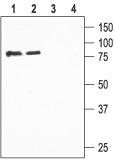Scnn1b Rabbit Polyclonal Antibody
Other products for "Scnn1b"
Specifications
| Product Data | |
| Applications | WB |
| Recommended Dilution | WB: 1:200-1:2000; IHC: 1:100-1:3000 |
| Reactivities | Mouse, Rat |
| Host | Rabbit |
| Clonality | Polyclonal |
| Immunogen | Peptide EFNYRTIEESPANNI(C), corresponding to amino acid residues 498-513 of rat ENaCÃ?. Extracellular. |
| Formulation | Lyophilized. Concentration before lyophilization ~0.8mg/ml (lot dependent, please refer to CoA along with shipment for actual concentration). Buffer before lyophilization: Phosphate buffered saline (PBS), pH 7.4, 1% BSA, 0.025% NaN3. |
| Purification | Affinity purified on immobilized antigen. |
| Conjugation | Unconjugated |
| Storage | Store at -20°C as received. |
| Stability | Stable for 12 months from date of receipt. |
| Gene Name | sodium channel epithelial 1 beta subunit |
| Database Link | |
| Background | The amiloride-sensitive epithelial Na+ channel (ENaC) family includes 4 members: ENaCα, β, γ and δ. The ENaC subunits have a conserved topology consisting of two membrane-spanning domains with intracellular N and C-termini and a large glycosylated extracellular region. The functional ENaC channel is a heteromer with a presumed stoichiometry of α2βγ while the δ subunit can substitute for the α subunit in some tissues. Interestingly, neither the β nor the γ subunits are capable of producing any current when expressed alone in heterologous systems, while in these systems the simultaneous presence of all three ENaC subunits will produce Na+ currents that resemble the endogenous channel. The ENaC channel is located in the luminal (apical) plasma membrane of several epithelial tissues such as kidney, lung, salivary glands and skin where it enables entry of Na+ into the cell along its electrochemical gradient and thus has a central role in the maintenance of renal Na+ balance as well as liquid balance in the lung. The central role of ENaC in the regulation of Na+ homeostasis and hence blood pressure is underscored by the identification of two human diseases that arise from either gain- or loss-of-function mutations of the ENaC channel. Liddle’s syndrome is an inherited form of hypertension that stems from a dominant mutation of the ENaC channel (in either the ß or γ subunits) that results in excessive activity of the channel and hence increased Na+ absorption. Conversely, pseudoaldosteronism type I (PHA) is a dysfunction characterized by hypotension due to poor Na+ absorption that is associated with loss-of-function mutations which may occur in each of the three ENaC subunits. |
| Synonyms | BESC1; Beta-ENaC; Beta-NaCH; ENaCb; ENaCbeta; SCNEB |
| Reference Data | |
Documents
| Product Manuals |
| FAQs |
{0} Product Review(s)
0 Product Review(s)
Submit review
Be the first one to submit a review
Product Citations
*Delivery time may vary from web posted schedule. Occasional delays may occur due to unforeseen
complexities in the preparation of your product. International customers may expect an additional 1-2 weeks
in shipping.






























































































































































































































































 Germany
Germany
 Japan
Japan
 United Kingdom
United Kingdom
 China
China



